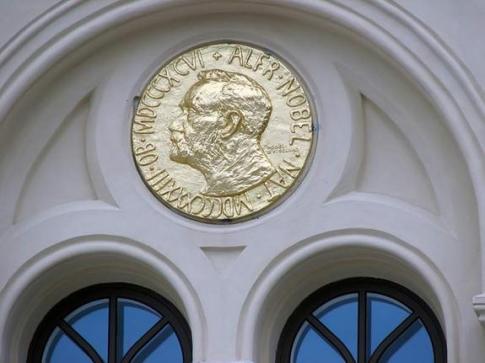Nobel Prize 2013: Chemistry

“This year’s prize is about taking the chemical experiment to cyberspace,” the Nobel Committee announced this morning, before giving this year’s chemistry prize to three scientists for their work on computer models of chemical interactions.
Posted by Ewen Callaway
“This year’s prize is about taking the chemical experiment to cyberspace,” the Nobel Committee announced this morning, before giving this year’s chemistry prize to three scientists for their work on computer models of chemical interactions.
The winners are Martin Karplus, at the University of Strasbourg in France and Harvard University in Cambridge, Massachusetts, Michael Levitt of Stanford University in California, and Arieh Warshel, at the University of Southern California in Los Angeles.
“Chemists used to create models of molecules using plastic balls and sticks. Today, the modelling is carried out in computers. In the 1970s, Martin Karplus, Michael Levitt and Arieh Warshel laid the foundation for the powerful programs that are used to understand and predict chemical processes,” the Noble Committee said in a press release. The trio came up with methods that melded the simplicity of classical Newtonian physics with the exquisite detail of quantum physics, making it possible to model complex chemical reactions, such as how a drug interacts with a protein target. In that example, quantum calculations would reveal the detailed chemical interactions between the drug and the portion of protein to which it binds, while classical physics methods would deal with the rest of the protein.
My colleague Richard Van Noorden will have a full account up soon on Nature’s news homepage.
Previous Chemistry Nobelists include: Brian Kobilka and Robert Lefkowitz in 2012, for their work on G-protein coupled receptors (see: “Cell signaling work nets chemistry Nobel“); Daniel Schectman in 2011, for the discovery of quasi-crystals (see: “Impossible crystals snag chemistry Nobel“); and Richard Heck, Ei-ichi Negishi and Akira Suzuki in 2010, for developing new chemical synthesis methods (see “Chemistry Nobel won by…chemists“).
The headline to that last story underscores the fact that the chemistry prize has often been doled out to life sciences – 4 out of the last 7, including this year. But this is not a recent trend. Between 1950 and 2000, life sciences topics have garnered 15 Chemistry Nobels, by my count. Granted, many of these are for chemical insights into biomolecules such as proteins and RNA.
Update 11:59 a.m.
Our sister journal Nature Structural & Molecular Biology published a 2001 essay by Levitt titled “The birth of computation structural biology,” in which he describes some of the work that garnered this year’s chemistry prize. It’s a nice account, with a couple writerly touches (“While Warshel and I were travelling around the world, our computer program, CFF, had wings of its own.”).
The essay’s title also underscores how important their work has been for biologists. The first applications of their methods were used to model proteins and other big biomolecules, and Levitt certainly saw his work opening doors for future life scientists. “Computers were made for biology,” he writes. “Biology would never have advanced as it did without the dramatic increase in computer power and availability. One day we would like to be able to simulate complicated biological processes, perhaps even going from the genomic sequence to a full simulation of the organism’s phenotype.”
But as the Nobel Committee points out in their account (PDF here), “the strength of the methods that Martin Karplus, Michael Levitt and Arieh Warshel have developed is that they are universal. They can be used to study all kinds of chemistry; from the molecules of life to industrial chemical processes. Scientists can optimize solar cells, catalysts in motor vehicles or even drugs, to take but a few examples.”
Update 12:51 p.m.
The work of Karplus, Levitt and Warshel has launched a super-computing arms race to model protein structures in nanoseconds instead of hours or days, according to a 2008 Nature feature titled “Power Play“. The story profiles Klaus Schulten, a protein modeler at the University of Illinois in Urbana-Champaign, whose computer program NAMD (Nanoscale Molecular Dynamics) was once the best tool for modelling the behaviour of individual atoms in protein. “But the German-born physicist got his wake-up call in 2006, when he saw a table of computing benchmarks in a report from that year’s supercomputing conference in Tampa, Florida. A new program called Desmond, he saw, could calculate each step of a standard molecular-dynamics simulation — the 23,558 atoms in a system involving the protein dihydrofolate reductase — in a little over a thousandth of a second. NAMD was ten times slower.”
Update 2:09 p.m.
In one of the papers cited by the Nobel Committee, “Computer Simulation of Protein Folding“, Levitt and Warshel describe one of the earliest efforts to use computers to predict the structure of a protein. Traditionally, scientists determined precise protein structures through x-ray crystallography – a sometimes tedious technique in which a crystalline form of a protein is bombarded with x-rays, and its structure inferred from the diffraction patterns. Levitt and Warshel’s method accurately simulated how a protein called bovine pancreatic trypsin inhibitor folds into its native shape. Protein structure prediction has since exploded as a research field, in part driven by a “contest” called CASP (for Critical Assessment of protein Structure Prediction), in which researchers are challenged to design computer programs that can predict a series of protein structures that have been determined experimentally, but not yet published.
Update 2:22 p.m.
An emerging area of research, in which proteins are designed to perform a particular task such as eliciting an immune response against HIV or catalyzing a chemical reaction, also relies heavily on the work of Karplus, Levitt and Warshel. For more check out previous Nature coverage: “Proteins made to order” and “The shape of protein structures to come“.
/Nature




 del.icio.us
del.icio.us Digg
Digg

Post your comment